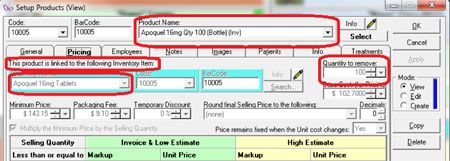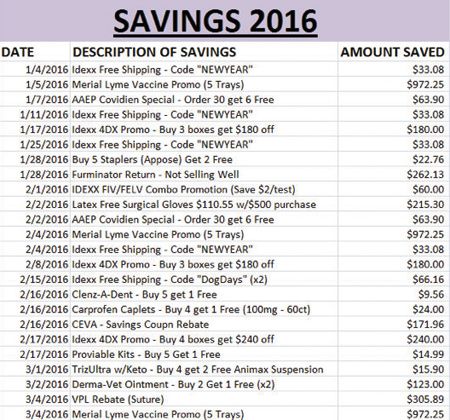How I saved more than $100,000 for my hospital
If it's too expensive to hire somebody like me (we're worth our weight in gold, come on), try seven other tweaks to get your veterinary practice inventory better managed and lower priced.
How nice would it be to save your clinic more than $100,000, eliminate the headaches of a transition to paperless practice and not have to deal with inventory issues?
It'd be great, right?
That's me. My position-inventory manager/electronic medical record specialist-was created at Animal Hospital of Oshkosh in Oshkosh, Wisconsin, to do just that. In my first year, the clinic saved nearly $60,000 in inventory savings and another $60,000 in captured charges.
You can do it too.
8 tips for veterinary inventory management
A common theme I hear from clinics that are already paper-light or paperless is that the inventory portion of their practice management software is not up to par. Let's make it happen.
1. Hire a full-time inventory manager. I thought I'd start with the most expensive-but the easiest-solution to your problems. I completely understand that not all clinics can afford this “luxury.” However, inventory is the second largest cost in a veterinary hospital, so dedicate at least a portion of a team member's job to this. The executive team at my hospital did not take this task lightly. The money I save every year must cover my salary and also benefit the hospital.
2. Clean up your practice management software. Nearly two months of my time in the beginning was spent “cleaning up” the medical record and practice software. Give someone the time to rid your system of anything that's not relevant to your practice today. This makes it easier to automate your charges. And by eliminating missed charges, you'll save your clinic nearly $60,000 a year.
Here's an example: I went through my entire active product and inventory list and made any item "inactive" that wasn't in the hospital. Then I made sure product and inventory items were attached to one another. If a product isn't precisely and accurately linked to an inventory item, that's when your inventory counts go wrong. My pro tip for you is, make sure the “amount” matches. In my screenshot below, I make sure the product description for 100 pills of 16-mg Apoquel is equal to one product slot when invoicing.

Screenshot courtesy of author
3. Eliminate duplicate products. Do you need six different canine NSAIDs? Do you need seven different shampoos that do roughly the same thing? By eliminating similar products, more doctors will be on the same page and your practice will receive better deals from manufacturers and distributors. We currently use one shampoo/dermatology line and receive constant benefits, like "Buy five, get one free."
4. Build relationships with sales reps and vendors. Half of my job is building relationships with people in this area. I've dubbed my favorite vendor and sales rep the “Dream Team.” Do the same, and you'll hear about promotions before they start, get inventory faster than other people, and be saved from buying things too fast or in too high quantity. I love getting this phone call: “Can you order this on Tuesday instead? You'll get one free then.” Also, you can use your favorite vendors to help you with staff incentives and clinic promotions. Great relationships and loyalty to a few vendors increases savings.
5. Get involved with marketing. I know it sounds crazy that the inventory manager is part of this, but after my executive team was asking for reports and numbers, it was a natural step in my evolution here. We created a “Monthly Marketing Campaign” using many of the metrics we measure to increase revenue and the average client transaction throughout the month. In a marketing flier, I emphasized aspects of senior wellness work, for instance, that included early detection lab work. I bought some items for seniors-neutraceuticals, in-house lab work supplies and Dasuquin Advanced, for instance. Many of the numbers the executive team was watching I was watching as well due to ordering the product.
6. Squeeze your sales reps for business insight. This is not about sneaking inside knowledge about your competitors. It's about the fact that your reps visit many clinics and see what's working and what's not. One of the best decisions we made was getting creative with our flea and tick preventive rep. We had the highest compliance in the area for heartworm preventives, but flea and tick lagged behind. Our rep helped us create marketing material for “Gold” and “Silver” packs. These “packs” were a way to sell 12 heartworm preventive doses and 12 or six flea and tick preventive doses. With these packs and rebates for our clients, our flea and tick sales increased 51 percent. This was huge for our clinic. This also helped move the product that we had already purchased through the clinic and out the door.
7. Cut down on special orders. We were slowing down to make special orders for clients whenever they called or walked through the doors-any time, any day. By “training” clients that special orders were placed on Mondays and Thursdays, we saved $14.90 every week on shipping charges. That may not seem like a lot, but over the course of a year we saved $774.80 in shipping costs alone. Many times the clients will also bring their pet in for a service as well when the special order has arrived.
8. Enroll in loyalty programs and track everything. My sales and vendor Dream Team (remember them from No. 4?) hits me up with savings opportunities all the time, especially loyalty programs. With loyalty programs, you receive price breaks, incentives and free products. Loyalty programs alone saved my clinic nearly $40,000 in 2016. Once you start to see the benefits of loyalty programs coming in, start tracking everything. I use an Excel spreadsheet. Even if you're receiving something as small as a $12 bonus, track it. It all adds up! I update the executive team on savings quarterly. Now we're really gaining momentum with the loyalty programs on products we'd be using anyway.

Examples of savings with loyalty programs and promotional deals with veterinary manufacturers, distributors and sales reps.
My final advice is, get creative. Try new things, and you'll find ways to increase revenue in different areas of your clinic that will, in the end, add to your savings totals.
Stephanie Zeddies is inventory manager and electronic medical record specialist at Animal Hospital of Oshkosh in Oshkosh, Wisconsin.